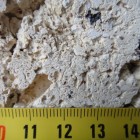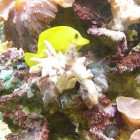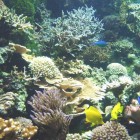 Natural live rocks are used in reef aquariums to bring live elements, micro-organisms and bacteria, essential to the good working of the aquarium.
Natural live rocks are used in reef aquariums to bring live elements, micro-organisms and bacteria, essential to the good working of the aquarium.
These rocks are taken in the coral reefs and are imported by plane.
Aquaroche created ceramic rocks, which, once they are seeded can be used as live rocks for reef aquariums, with the same effects.
Artificial aquaroche rocks for reef aquariums: not only a decor but also a complete ecosystem.
Because of their porosity, ceramic materials are very often used in aquarium filtrations as support for bacteria.
In the same idea, Aquaroche made ceramic decors and rocks with a very good and elaborated porosity.
As with live rocks, the whole aquaroche decoration acts as a filtration and refuge for bacteria and micro-organisms.
The distinctive feature of Aquaroche decors, compared to resin or compact natural stones, is that in a few months they will colonise and become « live »rocks.
Porosity and bacteria – how does live rocks work?
First, the aim is to transform fish dejections into ammonia, then ammonia into nitrites and finally nitrites into nitrates which are partly absorbed by algae and plants but can also partly remain in the aquarium.
This is what happens in filters of fresh water aquariums and ‘fish only’ marine tanks.
The functioning is assured by bacteria which live in an environment rich in oxygen and which are fixed on the more or less porous surface of filtration material.
These bacteria are naturally brought by plants and live elements of the aquarium or are introduced with specific ‘starting up’ products.
Nitrates are little toxic, but in reef aquariums with certain very sensitive corals, we look for rates of nitrates close to 0.
Other kinds of bacteria can then reduce these nitrates to gaseous nitrogen (which escapes naturally). These bacteria live in very poor in oxygen environment (anaerobic) for example in the heart of a ‘deep sand bed’ or in the heart of thick rocks.
The qualities required for these future live rocks are a little bit complicated because on one side you need an opened porosity for a big capacity of degradation and on the other you need a closed environment to limit the oxygen.
An example of appropriate material: some very good live rocks, made of superposition of different porous coats. Trying to reproduce the structure of these rocks, we developed and increased the porosity of our ceramic rocks; products corresponding to these criteria are grouped under our label: LiVe Rock Function (LV)®.
Ceramic rocks, Eco reef plates, Reef system, sculptured rocks / LV.
Aquaroche porosity = LiVe Rock Function – LV
To be very precise, purifying bacteria are between 1,2 and 1,5 µ. For a good colonisation, they need a shelter with open pores, ideally with a bottle shape, 20 µ to 100 µ. We worked the porosity of our rocks so that they have a maximum of open pores, linked together and to a net of canals and fissures from 100 µ to a few millimetres where a micro fauna can develop.
This porosity is active on the surface but also inside the rocks like good natural live rocks.
The porosity is regular.
 On the pictures, you can see the partial cut of a rock, with the different canals, fissures and pores.Dimensions of rock : 20 x 25 x H 8 cm, cut part: 10 x 7 cm, the close view corresponds to 6 x 5 cm.
On the pictures, you can see the partial cut of a rock, with the different canals, fissures and pores.Dimensions of rock : 20 x 25 x H 8 cm, cut part: 10 x 7 cm, the close view corresponds to 6 x 5 cm.
Our label and logo « LiVe Rock Function ® »
 All our rocks with this specific porosity have the
All our rocks with this specific porosity have the
« LiVe Rock Function ® »- LV label.
Design by Claire Chiquet.
Colonisation in bacteria – fresh water aquarium.
Rocks coming from an ‘old’ fresh water aquarium can be used to start a new one.
Cichlid fish aquariums, with a large décor made of our ceramic rocks, are very well equilibrated.
Colonisation in active bacteria – reef aquariums.
 Very good live rocks required for reef aquariums have to be colonised by many micro organisms, bacteria and algae and have an ideal porosity.
Very good live rocks required for reef aquariums have to be colonised by many micro organisms, bacteria and algae and have an ideal porosity.
An old tyre, even covered with coralline algae will never be a live rock… ;-)))
Our rocks, with their specific porosity can be colonised by contact with wild live rocks in your private aquariums but can also be found in shops, already colonised par producers.
With these rocks, one obtains a regular and controlled quality, with acclimated organisms.
On a large scale: Océanopolis.
Savoir-faire and experience.
Many saltwater aquariums have been equipped and working for years with our ceramic rocks.
 An example that everybody can visit is the great coral tank in Océnaopolis in Brest (France), installed in 2001. Total quantity of rocks: 5 tons with 70 % of new ceramic rocks and 30% wild live rocks for an aquarium of 60 000 litres…
An example that everybody can visit is the great coral tank in Océnaopolis in Brest (France), installed in 2001. Total quantity of rocks: 5 tons with 70 % of new ceramic rocks and 30% wild live rocks for an aquarium of 60 000 litres…
Note that these rocks were the old version and that the porosity has been improved since 2005.
 Deutsch
Deutsch  Français
Français 